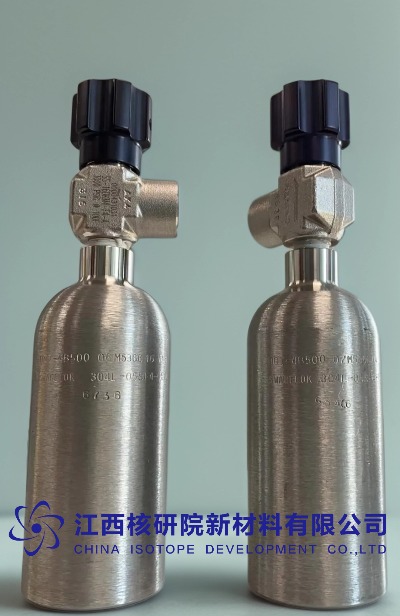Xe-129 Isotope Supply Solutions: Enabling Quantum Magnetometers and Spin-Based Sensors
BY Tao, Published Aug.15, 2025
The demand for stable isotopes like Xe-129 has surged in quantum technologies, where its unique nuclear spin properties enable ultra-sensitive magnetometers and spin-based sensors capable of detecting magnetic fields at the femtotesla level. As a nuclear research expert with over three decades in rare gases and isotopes, I’ve seen how reliable Xe-129 supply chains are critical for advancing these devices, from laboratory prototypes to commercial applications in navigation, medical diagnostics, and fundamental physics. This article explores the production, applications, and supply solutions for Xe-129 isotope, emphasizing its role in quantum magnetometers and spin-based sensors while addressing the need for high-purity enrichment to support these cutting-edge innovations.
The Nuclear Properties of Xe-129 and Its Quantum Potential
Xenon-129 stands out among noble gas isotopes due to its spin-1/2 nucleus, which offers long coherence times and minimal quadrupole interactions, making it ideal for quantum sensing. In hyperpolarized form, Xe-129 achieves polarization levels far beyond thermal equilibrium, amplifying nuclear magnetic resonance signals by orders of magnitude. This hyperpolarization is typically accomplished through spin-exchange optical pumping, where laser-polarized alkali metal vapors like rubidium transfer spin alignment to Xe-129 nuclei, resulting in polarization fractions up to 60%.
The isotope’s natural abundance of about 26% in atmospheric xenon necessitates enrichment for quantum applications, where purity levels above 99.99% minimize signal dilution from other isotopes like Xe-131, which has a spin-3/2 and can introduce unwanted relaxation effects. In quantum magnetometers, hyperpolarized Xe-129 serves as a probe for weak magnetic fields, leveraging its gyromagnetic ratio of approximately 11.78 MHz/T to detect perturbations with exquisite sensitivity. Spin-based sensors further exploit Xe-129’s ability to couple with electron spins in hybrid systems, enabling cooperative amplification that enhances detection limits.
From my experience in isotope research, the transition from basic NMR to quantum sensing has been driven by Xe-129’s inert nature and tunable relaxation times, which range from seconds in gas phase to minutes in optimized environments. These properties allow for portable sensors that outperform traditional superconducting quantum interference devices in room-temperature operation, opening doors to real-world applications like geomagnetic mapping and biomagnetic imaging.
Production and Enrichment Methods for Xe-129 Isotope
Producing high-purity Xe-129 involves a series of sophisticated steps, starting with the extraction of xenon from air via fractional distillation. The raw xenon, containing roughly 26% Xe-129, undergoes isotopic enrichment through gas centrifugation, where high-speed rotors separate isotopes based on mass differences. This method can achieve enrichment levels exceeding 90%, with advanced multi-stage cascades pushing purity to 99.99% or higher for quantum-grade material.
Post-enrichment, the Xe-129 is purified using cryogenic traps and getter systems to remove trace impurities such as oxygen or hydrocarbons, which could quench hyperpolarization. For quantum sensing, the gas is often hyperpolarized on-site using continuous-flow optical pumping systems, integrating narrow-linewidth lasers at 795 nm for rubidium excitation. These systems can produce liters of hyperpolarized Xe-129 per hour, with polarization efficiencies improved by buffer gas mixtures like helium to reduce wall relaxation.
Emerging techniques include microwave-assisted pumping to enhance spin transfer rates and cryogenic-free methods that avoid liquid nitrogen cooling, making production more accessible for field-deployable sensors. In large-scale facilities, electromagnetic isotope separation complements centrifugation for ultra-high purity batches, ensuring isotopic homogeneity critical for coherent spin manipulation in quantum devices.
Key steps in the production process include:
- Air Separation and Initial Distillation: Isolating xenon from atmospheric gases to yield a crude mixture.
- Centrifugal Enrichment: Cascaded rotors concentrating Xe-129 to desired purity levels.
- Purification and Quality Assurance: Cryogenic and chemical methods removing contaminants, followed by mass spectrometry verification.
- Hyperpolarization Integration: On-demand optical pumping for immediate use in sensors.
These methods ensure a stable supply of Xe-129 isotope, tailored to the stringent requirements of quantum magnetometers and spin-based sensors.
Applications in Quantum Magnetometers
Quantum magnetometers utilizing Xe-129 isotope have revolutionized magnetic field detection, offering sensitivities down to 10 fT/√Hz in compact, non-cryogenic setups. In these devices, hyperpolarized Xe-129 acts as a spin-precession sensor, where external magnetic fields cause Larmor precession detectable via optical readout with embedded alkali magnetometers. Cooperative spin amplification, achieved by feedback loops between Xe-129 nuclear spins and rubidium electron spins, boosts signal gain, enabling detection of biomagnetic signals like those from the human heart or brain.
One prominent application is in geophysical exploration, where Xe-129 magnetometers map subsurface anomalies with higher resolution than conventional tools, aiding in mineral detection and earthquake prediction. In medical contexts, they facilitate non-invasive monitoring of neural activity, surpassing EEG in spatial accuracy by resolving fields from individual neuronal clusters. Recent developments include hybrid systems integrating Xe-129 with diamond nitrogen-vacancy centers, combining the gas’s long coherence with diamond’s robustness for hybrid quantum sensing.
Quantitative performance in these magnetometers includes bandwidths up to 1 kHz and dynamic ranges spanning nanoTesla to milliTesla, making them versatile for both DC and AC field measurements. From my perspective, the scalability of Xe-129 supply has been key to transitioning these from lab curiosities to practical tools, with ongoing refinements in polarization lifetime extending operational windows to hours.
Spin-Based Sensors Enabled by Xe-129
Spin-based sensors leverage Xe-129’s nuclear spin as a quantum bit for probing environmental parameters beyond magnetism, such as rotation, acceleration, and electric fields. In comagnetometers, Xe-129 pairs with Xe-131 or alkali vapors to cancel common-mode noise, achieving sensitivities that test fundamental physics like Lorentz invariance. These sensors detect anomalous spin couplings, potentially revealing new particles or dark matter interactions.
In optical atomic magnetometry variants, hyperpolarized Xe-129 enhances nonlinear magneto-optical rotation, where frequency-modulated light interrogates spin precession for vector field mapping. Applications extend to inertial navigation systems, where Xe-129 gyroscopes provide drift-free orientation in GPS-denied environments, outperforming mechanical alternatives in precision. Biomedical spin sensors use Xe-129 to image molecular interactions, such as protein binding, via hyperCEST techniques that amplify signals from targeted hosts.
The versatility stems from Xe-129’s tunable spin dynamics:
- Coherence Times: Up to 1000 seconds in low-field environments for sustained sensing.
- Coupling Mechanisms: Van der Waals and dipole interactions for hybrid electron-nuclear systems.
- Detection Modalities: Optical, microwave, or NMR readout for multimodal operation.
- Scalability: Microfabricated cells containing Xe-129 for portable, array-based sensors.
These features position Xe-129 as a cornerstone for next-generation quantum technologies, where reliable isotope supply ensures consistent performance.
Product Specifications and Performance Metrics
Xe-129 isotope for quantum sensing is supplied as enriched gas in high-pressure cylinders or integrated hyperpolarization kits, with specifications optimized for magnetometers and spin sensors. Standard enrichment exceeds 99.99%, ensuring minimal isotopic interference, while chemical purity reaches 99.9999% to prevent relaxation losses. A typical batch yields 1-10 liters STP of Xe-129, with hyperpolarization systems delivering 40-70% polarization for 100-500 mL volumes.
Performance in quantum devices includes signal-to-noise ratios above 100 for femtotesla detection, with relaxation times (T1) of 20-60 minutes in sealed cells and T2 coherence up to 10 seconds. Operational parameters support field strengths from 1 nT to 1 mT, with bandwidths tailored via pulse sequences.
For detailed insights, the following table outlines key product attributes:
| Aspect | Details |
|---|---|
| Isotopic Enrichment | >99.99% Xe-129; <0.01% other xenon isotopes for optimal spin coherence. |
| Chemical Purity | >99.9999%; impurities <1 ppm (O2, H2O, etc.) to minimize quenching. |
| Supply Format | High-pressure cylinders (10-50 bar) or on-site hyperpolarization units. |
| Polarization Level | 40-70% via SEOP; signal enhancement 10,000-100,000x. |
| Volume Availability | 1-10 liters STP per batch; scalable for industrial needs. |
| Performance Metrics | Sensitivity: 10 fT/√Hz; coherence time: 10-1000 s; bandwidth: 0.1-1 kHz. |
| Storage Conditions | Cryogenic or room-temperature cylinders; hyperpolarized lifespan: 1-2 hours. |
| Usage Precautions | Handle in inert atmosphere; avoid magnetic gradients during polarization; monitor for depolarization via optical probes. |
| Side Effects/Safety | Inert gas; no toxicity; ensure ventilation to prevent asphyxiation in confined spaces. |
| Compatibility | Integrates with Rb/He buffer gases; suitable for microfabricated cells. |
These specifications guide users in deploying Xe-129 effectively, with precautions emphasizing GMP compliance for sensor fabrication.
Supply Chain Solutions and Challenges
Reliable Xe-129 isotope supply solutions involve a network of enrichment facilities, distribution partners, and on-demand hyperpolarization services. Major producers utilize stable isotope production facilities, ramping up output to meet quantum tech demands, with annual capacities reaching tons of enriched xenon. Logistics include cryogenic shipping for purity preservation and recycling programs to reclaim used gas, reducing costs and environmental impact.
Challenges include enrichment energy costs and geopolitical dependencies on air separation plants, but solutions like modular centrifuge units and international collaborations mitigate these. Custom supply contracts ensure purity traceability, with lead times shortened to weeks via automated production lines. In my view, integrating AI-driven demand forecasting will further streamline supplies, supporting the growth of quantum magnetometers and sensors.
Future Directions in Xe-129 Quantum Technologies
Looking ahead, Xe-129 isotope will drive innovations in distributed quantum sensing networks, where arrays of spin-based sensors enable real-time monitoring of geomagnetic fluctuations or biological fields. Advances in cryogenic-free hyperpolarization and hybrid diamond-Xe systems promise portable devices with attotesla sensitivities. As supply solutions evolve, Xe-129 will underpin quantum computing peripherals and precision metrology, transforming industries from healthcare to defense. With sustained investment in enrichment infrastructure, this isotope’s potential remains boundless, fostering a new era of spin-engineered discoveries.
Would you like a deeper dive into any specific technical parameters or applications?
(Follow up our update articles on www.asiaisotopeintl.com or send your comments to tao.hu@asiaisotope.com for further communications)








